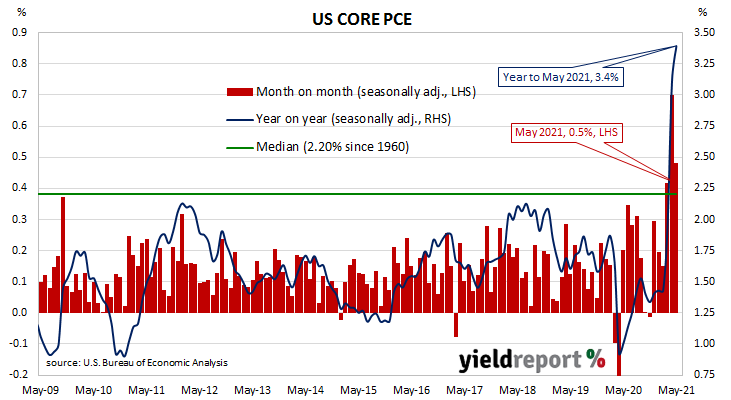Summary: US Fed’s favoured inflation measure increased by 0.5% in May; slightly below market expectations; annual rate accelerates further above 3%; Fed inflation projections “a difficult ask”; Treasury bond yields higher.
One of the US Fed’s favoured measures of inflation is the change in the core personal consumption expenditures (PCE) price index. After hitting the Fed’s target at the time of 2.0% in mid-2018, the annual rate then hovered in a range between 1.8% and 2.0% before it eased back to a range between 1.5% and 1.8% through 2019. It then plummeted below 1.0% in April 2020 before rising back to around 1.5% in the September quarter of that year.
The latest figures have now been published by the Bureau of Economic Analysis as part of the May personal income and expenditures report. Core PCE prices rose by 0.5% over the month, slightly below the generally expected figure of 0.6% and April’s 0.7% increase. On a 12-month basis, the core PCE inflation rate accelerated from April’s figure of 3.1% to 3.4%.
“For the Fed to meet its inflation projections, the monthly change in PCE inflation needs to fall to 0.18% pretty much immediately. That looks a difficult ask,” said ANZ economist Rahul Khare.

US Treasury bond yields increased on the day. By the close of business, the 2-year Treasury bond yield had inched up 1bp to 0.27%, the 10-year yield had gained 4bps to 1.53% while the 30-year yield finished 5bps higher at 2.15%.
The core version of PCE strips out energy and food components, which are volatile from month to month, in an attempt to identify the prevailing trend. It is not the only measure of inflation used by the Fed; it also tracks the Consumer Price Index (CPI) and the Producer Price Index (PPI) from the Department of Labor. However, it is the one measure which is most often referred to in FOMC minutes.

